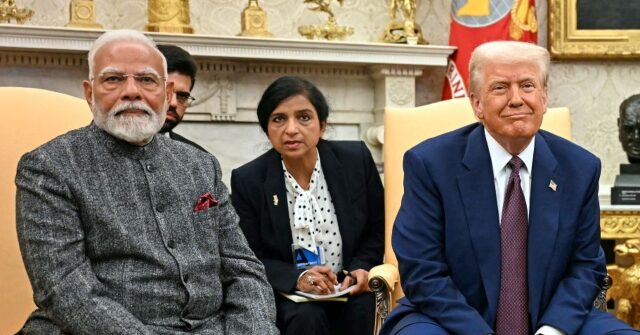President Donald Trump on Tuesday predicted India will reduce its tariffs to avoid the reciprocal tariffs Trump plans to impose on Wednesday, April 2, which he has proclaimed as “Liberation Day.”
“I think I heard that India just a little while ago is going to be dropping its tariffs very substantially, and I said, ‘why didn’t somebody do this a long time ago?’” Trump said at a press conference on Tuesday.
Trump added that many other countries “will drop their tariffs” because “they have been unfairly tariffing the United States for years.” He cited the European Union’s reduction of auto tariffs by 2.5 percent as an example of what he hopes to see.
White House Press Secretary Karoline Leavitt on Monday included India in a list of countries that “have been ripping off our country for far too long” and “made their disdain for the American worker quite clear.”
“If you look at the unfair trade practices — we have 50 percent from the European Union on American dairy, you have a 700 percent tariff from Japan on American rice. You have a 100 percent tariff from India on American agricultural products. You have nearly a 300 percent tariff from Canada on American butter and cheese,” she said.
“This makes it virtually impossible for American products to be imported into these markets, and it has put a lot of Americans out of business and work over the past several decades,” she argued.
Leavitt said it was “time for reciprocity, and it’s time for a president to take historic change, to do what’s right for the American people — and that’s going to take place on Wednesday.”
Indian and American representatives held trade talks in New Delhi last week. According to India’s Commerce Ministry, both sides have “broadly come to an understanding on the next steps towards a mutually beneficial, multi-sector Bilateral Trade Agreement (BTA), with the goal to finalize its first tranche by fall 2025.”
The Indian statement said nothing about taking immediate steps to avoid the April 2 tariffs, which could reduce India’s exports to the U.S. by over $7 billion next year. India has made a few small conciliatory tariff cuts, but has not yet offered anything on the scale envisioned by the Trump White House.
That might be about to change, as Indian media has been buzzing with speculation about emergency tariff reductions on U.S. automobiles, electronics, and medical products.
India’s PTI news service on Tuesday quoted sources in the Commerce Ministry who said analysts are working on different “scenarios” for how Trump’s tariffs could play out.
Concessions on some of India’s especially high trade barriers might be in the offing, as Trump hinted in his comments on Tuesday, although another strategy apparently under consideration is to stress the value of “non-tariff barriers” imposed by the U.S. to argue that the disparity between American and Indian tariffs is not quite as enormous as it appears.
That would be a tough sell to the Trump White House, as PTI noted the tariff differentials in certain sectors are very high indeed:
Currently, US goods face a weighted average tariff of 7.7 percent in India, while Indian exports to the US attract only 2.8 percent, leading to a 4.9 percent difference. Indian farm exports to the US currently face a 5.3 percent duty, whereas US farm exports to India face a much higher 37.7 percent, creating a 32.4 percent gap.
Trade experts said that at the broad sector level, the potential tariff gaps between India and the US vary across the sectors.
The gap is 8.6 percent for chemicals and pharmaceuticals, 5.6 percent for plastics, 1.4 percent for textiles and clothing, 13.3 percent for diamonds, gold, and jewelry, 2.5 percent for iron, steel, and base metals, 5.3 percent for machinery and computers, 7.2 percent for electronics, and 23.1 percent for automobiles and auto components.
As for the non-tariff barriers Indian officials want to highlight, they include “the U.S. banning export of wild-caught shrimp from India on the grounds that Indian trawler vessels were not using Turtle Excluder Devices; private standards of American companies; and high registration costs for sectors like pharma.”
PTI reported the Indian Commerce Ministry is “developing a portal for registering non-tariff barriers (NTBs) faced by exporters.” The system is “currently working on beta mode,” but could be fully operational within two months.
Read the full article here
